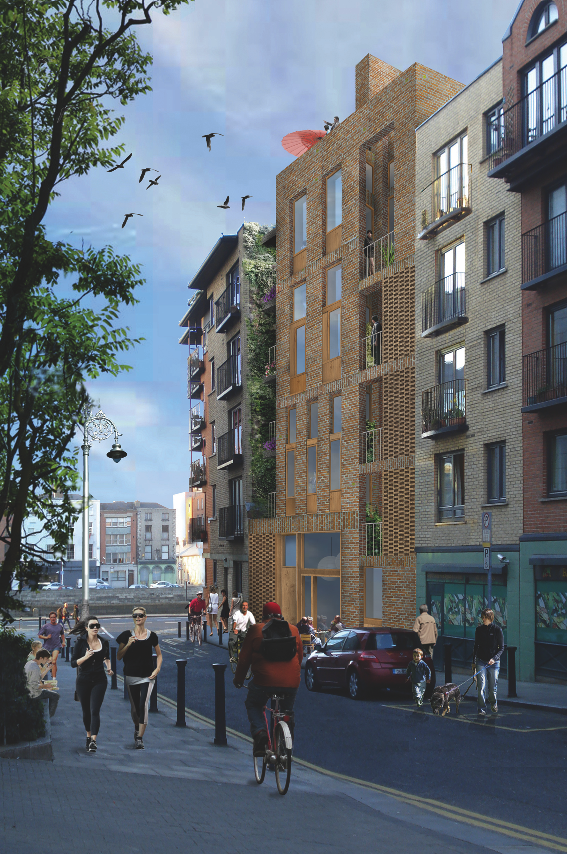What’s the best way to tell area residents about plans for a new asylum shelter nearby?
The government should tell communities directly about plans for new asylum shelters, some activists and politicians say.
A project to let citizen developers build homes in the inner city sounded like such a good idea when it was first floated in the depths of the recession. Unfortunately, it has fallen at an early hurdle.

“Wouldn’t you love to create your own home in the heart of Dublin City – for yourself or your family?” That was the alluring prospect of a Dublin City Council project created by its City Architect’s department. Unfortunately, it has fallen at the first fence.
The Dublin House project sounded like such a good idea when it was first floated by City Architect Ali Grehan in the depths of the recession – to provide small sites in the inner city for co-ops of “citizen developers” to design and build “bespoke homes” for themselves.
It took a while to get going, largely because of scepticism among the financial institutions. But eventually, individuals, couples and even families were invited in July 2014 to put together proposals for a small-scale residential development on a derelict site on Fishamble Street.
At its launch, then Lord Mayor Christy Burke said he was “delighted that Dublin City Council is introducing the Dublin House project as another initiative to encourage and enable families to live in the city centre”, and that he looked forward to seeing the initiative succeed.
Grehan explained that Dublin House aimed to promote “diverse owner-occupied city centre family friendly homes” by offering people an opportunity to “come together as a group to design and develop the site in a way that suits their housing needs today and into the future”.
Thus, the council was prepared to sell the site at 29 and 30 Fishamble Street to a group of households who would be required to design, build and finance its redevelopment and to remain living in the new apartments as their primary place of residence for a period 10 years.
The objective of this “exemplar project” was to “demonstrate that family friendly apartments are possible and desirable within the city centre”. However, it was made clear at the outset that interested parties “do not need to have children to be considered” for the scheme.
“The council sees its role as providing the site and offering in-kind support to the successful group of households so that this particular vacant site can become a model of international best practice as well as reintroducing residential use back into this historic part of the city.”
The successful group of households was to be selected from a lottery of completed application forms from eligible groups. There had to be a maximum of four households in each group, and “written confirmation must be provided that sufficient financial resources are in place”.

Those who won the tender commissioned architects GKMP to design a five-storey apartment building for the Fishamble Street site, but there were disagreements among its members about basic issues such as whether the roof terrace would be open or perhaps even compartmentalised.
On 4 November, an update on the Dublin House website announced that the group selected to develop the site – reportedly consisting of young lawyers – “have withdrawn their expression of interest” after what was “a learning experience for all involved”.
The notice said that the city council “remains committed to the Dublin House initiative as providing an important contribution to the debate on promoting high-quality apartment living in the city. Dublin City Council is at present reviewing how best to progress this aim.”
The idea of “citizen developers” getting together to provide housing for themselves has been successful elsewhere in Europe, as architects Greg Jackson and Donal Groarke noted in 2013 when they launched a similar initiative as an alternative to buying a new home “off the shelf”.
“It promises higher quality, more space, closer community, a ‘say’ by owners in the design and, perhaps most interestingly for many, it is 25% below the usual property developer option,” they said. In effect, it would “remove the developer and his 25%-plus profit.”
As Jackson and Groarke explained, the concept “can relate to a site or a particular idea about how people might want to live. Projects can range from family homes to retirement and eco-communities”. Examples are shown on their website.
“In Europe there are long waiting lists for people to join such groups,” according to Greg Jackson, who did a master’s degree thesis on citizen development. “It’s a no-brainer. The quality is higher, being based on the homeowner’s needs and not the developer’s profit . . . and its 25% cheaper.”
Rather optimistically, Donal Groarke said: “This is a model for our times. Irish people are better informed and willing to embrace new concepts that have been successful elsewhere. They also have a keen eye for real value and an impatience with Celtic Tiger options in housing.”
Judging by what has happened in Fishamble Street, however, Irish people are not yet ready for the complexities and “give-and-take” involved in collaborating with others and with architects to design their own homes on a co-operative basis. And that’s really sad.
Get our latest headlines in one of them, and recommendations for things to do in Dublin in the other.